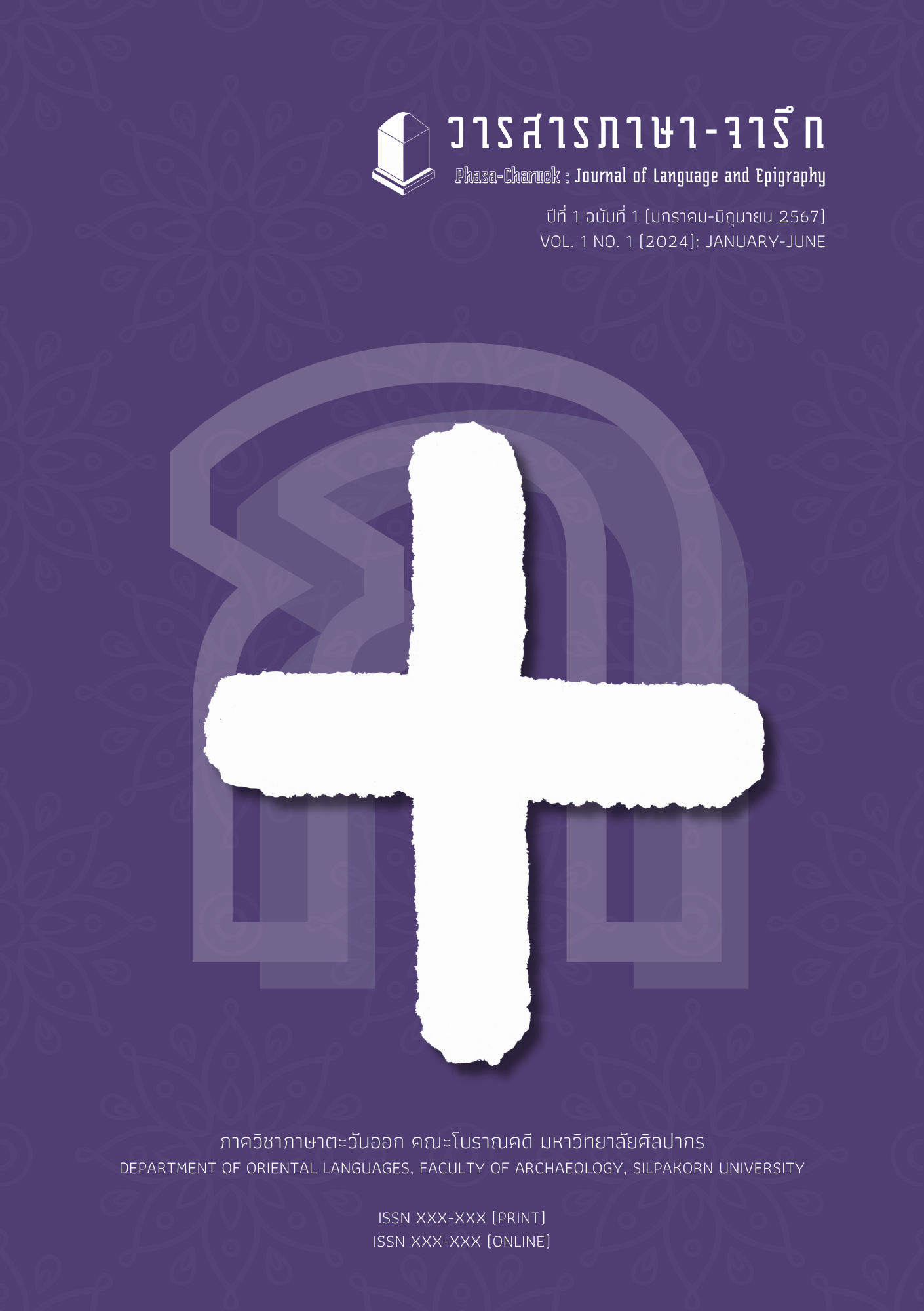The Chao Fa Savatthi inscription found at Wat Phra That Chae Haeng, Nan province
Main Article Content
Abstract
The Chao Fa Savatthi inscription found at Wat Phra That Chae Haeng in Nan province is a Fak Kham script inscription on two wooden boards. These are 1) The inscription of the vihara construction at Phra That Chae Haeng, Board 1 (NN. 236), which specifies the year of the vihara's construction as the "Year of Dap Rao" in the Tai calendar, corresponding to CS 947 (BE 2128). 2) The inscription of the vihara construction at Phra That Chae Haeng, Board 2 (NN. 237). This inscription is known only from a photograph of a copied reproduction, but it has the same handwriting as Board 1, suggesting it's also an inscription by Chao Fa Savatthi. The age of both inscriptions can be estimated to around BE 2131, based on the year the vihara was completed. This was during the time when Phaya No Kham Chai Sathian Songkhram was the ruler of Nan. The content of Board 1, besides narrating the vihara's construction, also reflects Lanna people's beliefs about relics and the legend of Phra Chao Liap Lok. It also mentions Buddhist predictions about Thao Kha Kan, the ruler of Nan, which differs from ordinary dedicatory inscriptions. Board 2 provides information about the quantity and materials used in vihara construction in ancient Lanna. Although the content of both inscriptions is incomplete and represents only a part of the remaining vihara construction inscriptions, they serve as valuable evidence for studying the early history of Nan when it was under Burmese control, as well as the history of Wat Phra That Chae Haeng.
Article Details

This work is licensed under a Creative Commons Attribution-NonCommercial-NoDerivatives 4.0 International License.
References
คณะกรรมการอำนวยการจัดงานฉลองสิริราชสมบัติครบ 50 ปี. (2545). ประชุมพงศาวดารฉบับกาญจนาภิเษก เล่ม 7. กรุงเทพฯ: กองวรรณกรรมและประวัติศาสตร์ กรมศิลปากร.
นวพรรณ ภัทรมูล. (2561). “จารึกบนแผ่นไม้กระดาน วัดพระธาตุแช่แห้ง : คำอ่านและปริวรรตรอบหลัง”. เข้าถึงเมื่อ 15 สิงหาคม 2565. เข้าถึงได้จาก https://db.sac.or.th/inscriptions/articles/detail/19427
บุปผา คุณยศยิ่ง. (2542). “ชุธาตุ.” สารานุกรมวัฒนธรรมไทย ภาคเหนือ 4: 1883-1887.
ประเสริฐ ณ นคร และคณะ. (2553). ภาคผนวก จ. “นน. 236 จารึกสร้างพิหารที่พระธาตุแช่แห้ง (แผ่นที่ 1) นน. 237 จารึกสร้างพิหารที่พระธาตุแช่แห้ง (แผ่นที่ 2).” ใน จารึกล้านนา ภาค 2 จารึกจังหวัดเชียงใหม่ ลำปาง ลำพูน และแม่ฮ่องสอน. กรุงเทพฯ: คณะกรรมการชำระประวัติศาสตร์ไทย.
พจนานุกรมศัพท์วรรณกรรมท้องถิ่นไทย ภาคเหนือ โคลงมังทรารบเชียงใหม่. (2552). กรุงเทพฯ: ราชบัณฑิตยสถาน.
ราชบัณฑิตยสภา. (2474). ตำนานพระธาตุแช่แห้งเมืองน่าน. พระนคร: โรงพิมพ์โสภณพิพรรฒธนากร, (พิมพ์ในงานพระราชทานเพลิงศพ มหาอำมาตย์โท เจ้ามหาพรหมสุรธาดา (มหาพรหม ณ น่าน) เจ้าผู้ครองนครน่าน ปีมะแม พ.ศ. 2474).
สงวน โชติสุขรัตน์. (2556). ประชุมตำนานล้านนาไทย. นนทบุรี: ศรีปัญญา.
สรัสวดี อ๋องสกุล. (2539). พื้นเมืองน่าน ฉบับวัดพระเกิด. กรุงเทพฯ: อมรินทร์พริ้นติ้งแอนด์พับลิชชิ่ง.
สุดแดน วิสุทธิลักษณ์ และณัฐพงษ์ ปัญจบุรี. ปริวรรตและอรรถาธิบาย. (2565). ตำนานพระเจ้าเลียบโลกฉบับวัดพระเกิด ตำบลในเวียง อำเภอเมือง จังหวัดน่าน. กรุงเทพฯ: คณะสังคมวิทยาและมานุษยวิทยา มหาวิทยาลัยธรรมศาสตร์.
อรุณรัตน์ วิเชียรเขียว และเดวิด เค. วัยอาจ. (2547). ตำนานพื้นเมืองเชียงใหม่. เชียงใหม่: ซิลค์เวอร์มบุคส์.
อุดม รุ่งเรืองศรี. (2547). พจนานุกรมล้านนา-ไทย ฉบับแม่ฟ้าหลวง. ฉบับปรับปรุงครั้งที่ 1. เชียงใหม่: ภาควิชาภาษาไทย คณะมนุษยศาสตร์ มหาวิทยาลัยเชียงใหม่.
ฮันส์ เพนธ์, พรรณเพ็ญ เครือไทย และศรีเลา เกษพรหม. (2547). พิมพ์ครั้งที่ 2. “1.7.2.1 วัดพระธาตุแช่แห้ง พ.ศ. 2128.” ใน ประชุมจารึกล้านนา เล่ม 4 จารึกในพิพิธภัณฑ์ฯ เชียงใหม่. เชียงใหม่: คลังข้อมูลจารึกล้านนา สถาบันวิจัยสังคม มหาวิทยาลัยเชียงใหม่.
Bock, Carl. (1884). Temples and Elephants: The Narrative of a Journey of Exploration Through Upper Siam and Lao. Accessed 15 October 2022. Available from D-Library | National Library of Thailand, http://digital.nlt.go.th/items/show/17225.
Conway, Susan. (2014). Tai Magic Art of the Supernatural in the Shan States and Lanna. Bangkok: River Books.
Pavie, Auguste. (1898). “XXIX, XXX, XXXI. Inscriptions Thaies.” In Mission Pavie. Indo-Chine 1879-1895. Etudes diverses II. Recherches sur l’Histoire du Combodge du Laos et du Siam. Paris: Ernest Leroux.

